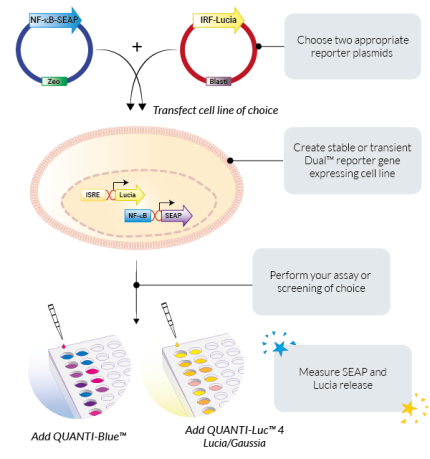Do-it-yourself Dual™ reporter cells
InvivoGen has designed the pNiFty plasmid collection to help develop exclusive Dual™ reporter cell lines that fit your research.
The inducible reporter plasmid families pNifTy2-N and pNiFty3-I enable the simultaneous monitoring of NF-κB and IRF activation upon pattern recognition receptor (PRR) stimulation. They are available with different antibiotic resistances including Blasticidin, Puromycin, or Zeocin®, and reporter genes such as SEAP, Lucia, Firefly, and Renilla luciferases (See the complete product list).
This allows you to create ideal Do-It-yourself Dual™ reporter cells in the species/tissue background of choice and develop the cell-based assay for your application of interest. Gain an in-depth understanding of how your therapeutic molecule simultaneously affects the NF-κB and IRF signaling pathways. When the pathway signaling is altered upon stimulation with your drug candidate, a change in the reporter gene expression occurs. These effects can be quantitatively assessed by measuring the activation of the reporter protein.
For your convenience, InvivoGen provides easy-to-use liquid detection reagents, QUANTI‑Blue™ and QUANTI-Luc™ 4, to evaluate the modulatory impact of your compound.
Key features
- Simultaneous monitoring of NF-κB and IRF signaling
- Large choice of reporter genes encoding for SEAP or luciferases, including Lucia, Firefly, or Renilla
- Provided with Blasticidin, Puromycin, or Zeocin® antibiotic resistance
- Simple, rapid, and cost-effective
Application
- Studying the PRR-or cytokine-mediated IRF and NF-κB-dependent pathways
- Adaptable for high-throughput screening (HTS)
- Suitable for screening for agonists or antagonists
- Compatible with biologics and small molecules
Create your own Dual™ cell line in three simple steps:
- Choose a parental cell type/line
Although InvivoGen already provides a number of ready-to-use Dual™ reporter cell lines including THP1-Dual™, Jurkat-Dual™, RAW-Dual™, and newly engineered HEK-Dual™, everyone's research is unique and requires flexible tools. Choose a parental cell type that suits your assay setup regarding gene expression profile, physiology (primary or immortalized cells), handling (soluble or adherent), and origin (murine or human).
- Co-transfect two inducible reporter plasmids
Select two inducible reporter plasmids from our extensive collection of pNiFty2-N and pNiFty3-I plasmids to simultaneously monitor the NF-κB and IRF signaling. To ensure maximum flexibility, these plasmids are available comprising a Blasticidin, Puromycin, or Zeocin® antibiotic resistance, as well as different reporter genes including SEAP, Lucia, Firefly, or Renilla luciferase. Of note, InvivoGen's Dual™ cells are composed of the pNiFty2-N-SEAP-Zeo and pNiFty3-I-Lucia-Blasti plasmids.
- Assessment of NF-κB and IRF-mediated responses
Perform your assay of interest and use InvivoGen's fine-tuned detection reagents, QUANTI‑Blue™ and QUANTI-Luc™ 4, to quantify the modulatory effects of your compound by measuring the changes in reporter protein expression. The monitoring of SEAP activation can be performed by simply observing the color change from pink to purple/blue in the supernatant or by reading the optical density using a spectrophotometer. Lucia and Renilla luciferase activity is assessed quantitatively using a luminometer in the supernatant and after cell lysis, respectively. These liquid formulations show a wide dynamic range, are highly sensitive, and are adapted for high-throughput screening (HTS).




